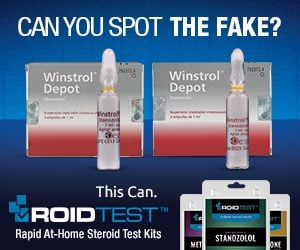Estrogenic Side Effects Background
Estrogen side effects can refer both to the side effects that result from rising levels of Estrogen that originate from aromatization, or from estrogenic side effects that result from other causes that are not related to the rise in E2 (Estradiol). This is very important for the reader to understand, as Estrogen side effects can have numerous causes. The majority of the Estrogen side effects discussed here can all be treated with the use of anti-estrogens, which will be expanded upon a great deal in the next subsection (Anti-Estrogens) of this article. The most common and prominent estrogenic side effects will be discussed here.
The most common and primary cause of gynecomastia is, of course, elevated E2 levels as a result of the extensive aromatization of androgens such as Testosterone, Dianabol (Methandrostenolone), or any other anabolic steroid that is aromatizable. Secondly, Estrogen side effects can also result from compounds that are not Estrogens by nature, but tend to also bind to the Estrogen receptors in the body. A perfect example of this is the anabolic steroid Anadrol (Oxymetholone), which is actually unable to aromatize due to the fact that it is a DHT-derivative, and one of the key characteristics of DHT (Dihydrotestosterone) is that the aromatase enzyme does not recognize it as a proper substrate. Thus, there is no aromatization into Estrogen with Anadrol, but instead it has been strongly speculated that Anadrol itself (and/or one or more of its metabolites) act as Estrogens at the Estrogen receptor in different tissues. Moving on to other causes of Estrogen side effects, the use of xenoestrogens can cause estrogenic effects as well, which will be touched upon later in this article (xenoestrogens are non-steroidal compounds that bear no resemblance to Estrogen, yet they bind to the Estrogen receptors in the body). Lastly, Estrogen side effects can result from rising levels of a different female ovarian steroid hormone, Progesterone (or the use of Progestins, which are Progesterone-like compounds), which can act to increase the sensitivity of the Estrogen receptor to Estrogens and worsen estrogenic side effects[1]. The result is an environment in which even the lowest Estrogen levels can trigger estrogenic side effects.
Gynecomastia
Gynecomastia (also referred to in short form as ‘gyno’) is, quite simply, the development of female-like breast tissue in men. It is perhaps the most commonly discussed estrogenic side effect resultant from anabolic steroid use, and is one of the most common Estrogen side effects. Gynecomastia is also quite frequent among young pubertal males[2] [3] as well as older males in the range of 45 years of age and older[4]. Furthermore, obese men and men with excessively high body fat percentages are common sufferers of gynecomastia, as research has found that a higher body fat percentage will present a higher risk of estrogenic side effects[5]. Although there are many cogs that work in the gynecomastia development machine (such as human growth hormone, Prolactin, Progesterone, IGF-1, and Estrogen), Estrogen tends to be the central causative determining agent, and an absolute requirement for the development of gynecomastia is that Estrogen must be present and levels must be very high in order for gynecomastia to occur. Although gynecomastia is highly concerning among males, it is far from a life-threatening Estrogen side effect, and is considered very much an aesthetically unpleasing and unattractive side effect.

Gynecomatia from steroidal estrogenic side effects
Water Retention (Bloating)
The water retention as a result of rising Estrogen levels can be one of the more potentially serious Estrogen side effects, but also carries with it an element of aesthetic attraction. The water retention caused by excessive Estrogen levels will commonly cause a soft and ‘puffy’ look to the physique that is commonly undesired by athletes and bodybuilders except for those who wish to put up with it (or even favor it) during bulking and mass-gaining phases. The risk that comes with water retention is the rising blood pressure that can raise to dangerous levels, as extracellular water flows through the circulatory system causing an increase in fluid pressure against the arteries and veins[6]. The estrogenic side effect of water retention originates from Estrogen’s activity on stimulating the release of hypothalamic arginine vasopressin (AVP), which is a hormone that is directly involved in the control of water flow in and out of the kidneys[7], and it is Estrogen that is responsible for this control of fluid retention in both males and females alike[8]. Hence, this is another reason why females naturally have more of a ‘softer’ look and feel than males do. Water is also retained subcutaneously beneath the skin (also referred to as peripheral water retention) and is what causes the soft, smooth, and puffy look in bodybuilders and athletes who tend to bulk up on heavy dosages of aromatizing anabolic steroids. Some might even say that the bloated, puffy look of a bodybuilder can be a telltale sign of Estrogen side effects, and therefore anabolic steroid use.
Benign Prostatic Hyperplasia and Prostate Cancer
Also abbreviated as BPH, the link that Estrogen has with prostate issues in men is a fairly recent discovery, as the prevailing school of thought for a very long time was that DHT (Dihydrotestosterone) was the primary aggressive culprit in the issue. This is true, but new evidence of Estrogen’s influential role makes Dihydrotestosterone (and androgens in general) only a part of the issue. First of all, there is a big difference between BPH and prostate cancer that must be clarified before moving forward. BPH is benign prostatic hyperplasia, which is the normal benign enlargement of the prostate gland, while prostate cancer is an actual carcinoma of the prostate. It should be made perfectly clear right now to the reader that although BPH can be uncomfortable, cause urination problems, and increase the risk of urinary tract infections (and subsequent inflammation), BPH does not lead to prostate cancer, and neither does it increase the risk of prostate cancer[9].
Further debunking the prostate cancer/BPH confusion, it has been observed that BPH and prostate cancer is indeed dependent on androgens, as when they are not present (as evidenced via castration) the progress of the disease is significantly reduced and even eliminated[10]. However, research has demonstrated that the administration of Testosterone in TRT patients does not have any effect on the development of prostate cancer[11], and neither are claims supported that there is an increased risk of prostate cancer in anabolic steroid users who use anabolic androgenic steroids at supraphysiological levels[12]. Evidence has also demonstrated that Testosterone levels in general have no direct link as a trigger to prostate cancer, though they are a necessary component[13].
Let’s move back to BPH, which is a natural part of the prostate development in early stages of male life and is necessary for the maintenance of the prostate throughout adult male life. Although necessary, the growth stimulation by androgenic anabolic steroids can increase the prostate size to uncomfortable levels and can cause issues mentioned earlier, such as increased urination frequency, urination problems, inflammation, discomfort, etc. While androgens such as Testosterone are known to play a central role, it is Estrogen that is known for playing an equally large (or even larger) role in prostate growth[14]. Estrogen seems to serve the role of increasing the number and proliferation of androgen receptors in the prostate gland, and therefore the increases in the number of androgen receptors results in a significant increase in growth rate even among a reduction in androgen levels[15]. Much like how gynecomastia is significantly influenced by the androgen:estrogen ratio shifting in favor of Estrogen, the issue of benign prostatic hyperplasia also seems to be affected in this way too.
Now, going back to prostate cancer quickly, there is very strong evidence demonstrating that Estrogen is indeed a strong cancer-causing agent where the prostate is concerned, where elevated levels of Estrogen are associated with prostate cancer. The evidence demonstrates changes in Estrogen receptor status in advanced prostate cancer as well as rodent models and chimeric human tissue graft models demonstrating induction of prostate cancer using Estrogen as well as Testosterone[16]. Furthermore a variety of different of Estrogen receptors have been discovered on the prostate gland, and Estrogen does not only exacerbate BPH (as mentioned earlier), but it also exacerbates malignant prostate cancer via receptor-mediated mechanisms, DNA-damaging, as well as potentially mutagenic activity of Estrogens and estrogenic compounds[17].
While all of this seems to paint Estrogen and its prostate-related side effects in a very grave light, there is some saving grace to Estrogen. There is evidence that in addition to the negative estrogenic side effects as it relates to the prostate, it also seems to exhibit some beneficial protective effects as well[18]. On the positive side, the stimulation of Estrogen receptor-beta can assist in the protection of the prostate from inflammation, hyperplasia, and some carcinogenesis. It is the Estrogen receptor-alpha that is responsible for negative effects mentioned earlier. It is safe to conclude, however, that a very high level of Estrogen seems more harmful for the prostate than beneficial as elevated levels of PSA have been recorded during anabolic steroid administration (both mild and heavily estrogenic anabolic steroids were used)[19].
Medical References:
[1] Roles of estrogen and progesterone in normal mammary gland development insights from progesterone receptor null mutant mice and in situlocalization of receptor. Shyamala G. Trends Endocrinol Metab. 1997 Jan-Feb;8(1):34-9.
[2] Gynaecomastia and breast cancer in men. Niewoehner, CB; Schorer, AE (March 2008). BMJ 336 (7646): 709–713. doi:10.1136/bmj.39511.493391.BE. PMID 18369226.
[3] Disorders of the Testes and Male Reproductive System Harrison’s principles of internal medicine (17th ed. ed.). Chapter 340. Fauci, Anthony S.; Eugene Braunwald, Dennis L. Kasper , Stephen L. Hauser, Dan L. Longo, J. Larry Jameson, and Kurt J. Isselbacher (2008). New York: McGraw-Hill. ISBN 978-0-07-147693-5.
[4] Gynecomastia: pathophysiology, evaluation, and management. Johnson, RE; Murad, MH (November 2009). Mayo Clinic Proceedings 84 (11): 1010–1015. doi:10.1016/S0025-6196(11)60671-X. PMID 19880691.
[5] Aromatization of androstenedione and 19-nortestosterone in human placental, liver, and adipose tissues (abstract). Nippon Naibunpi Gakkai Zasshi 62 (1986:18-25
[6] Salt, hypertension, and edema. Rossler R, Internist (Berl). 1976 Oct; 17(10):489-93. Review.
[7] Forsling, M. L., P. Stromberg, and M. Akerlund. Effect of ovarian steroids on vasopressin secretion. J endocrinol. 95: 147-151, 1982.
[8] Stachenfeld NS. Sex hormone effects on body fluid regulation. Exerc Sports Sci Rev. 2008 Jul;36(3):152-9.
[9] Chang RT, Kirby R, Challacombe BJ. Is there a link between BPH and prostate cancer? Practitioner. 2012 Apr;256(1750):13-6, 2.
[10] Benign hypertrophy and carcinoma of the prostate. Moore RA. Surgery 1944;16:152-67.
[11] Shabsigh R, Crawford ED, Nehra A, Slawin KM. Testosterone therapy in hypogonadal men and potential prostate cancer risk: a systematic review. lnt J Impot Res. 2008 Jul 17. [Epub ahead of print]
[12] Kanayama G, Hudson JI, Pope HG Jr. Long-term psychiatric and medical consequences of anabolic-androgenic steroid abuse: A looming public health concern? Drug Alcohol Depend. 2008 Nov 1;98(1-2):1-12. Epub 2008 Jul 2.
[13] Guilt by association: a historical perspective on Huggins, testosterone therapy, and prostate cancer. Morgentaler A. J Sex Med. 2008 Aug;5(8):1834-40. Epub 2008 Jun 10.
[14] Estrogen-regulated development and differentiation of the prostate. McPherson SJ, Ellem SJ, Risbridger GP. Differentiation. 2008 Jul;76(6):660-70. Epub 2008 Jun 28.
[15] Hadley M, Levine J. 2006. Endocrinology. 6th ed. Toronto: Pearson Education, pp. 403.
[16] Jason L Nelles, Wen-Yang Hu, and Gail S Prins. Estrogen action and prostate cancer. Expert Rev Endocrinol Metab. 2011 May; 6(3): 437–451.
[17] Maarten C Bosland, DVSc, PhD. The Role of Estrogens in Prostate Carcinogenesis: A Rationale for Chemoprevention. Rev Urol. 2005; 7(Suppl 3): S4–S10.
[18] G Risbridger, S Ellem et al. Estrogen action on the prostate gland: a critical mix of endocrine and paracrine signaling. J Mol Endocrinol (2007) 39,18388.
[19] Teruel JL, Aguilera A, Avila ·C, Ortuno J. Scand J Urol Nephrol. Effects of androgen therapy on prostatic markers in hemodialyzed patients. 1996 Apr;30(2):129-31.





